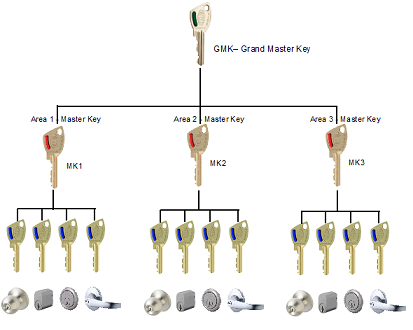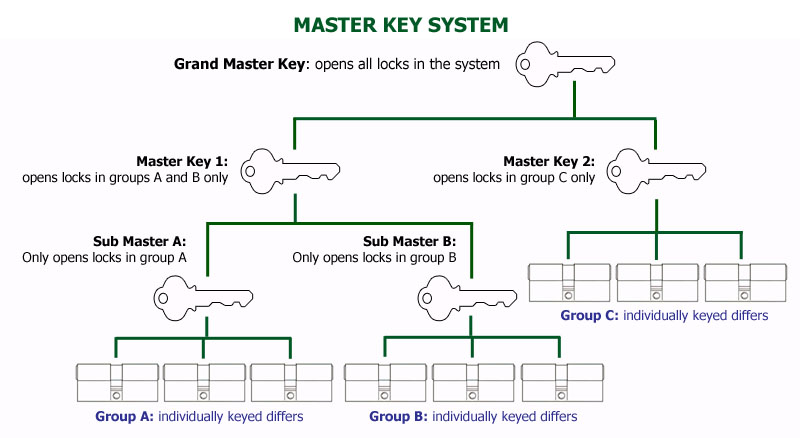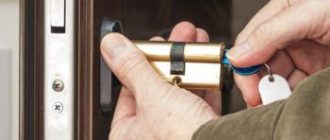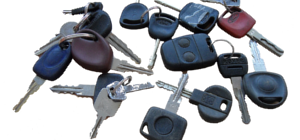
A Guide To Understanding A Master Key System
Are you interested in enhancing the security of your facility? One highly effective solution for managing access control is a master key system. With its intricate design and functional capabilities, understanding how this system works is crucial for any facility manager or security professional.
In this comprehensive guide, we will delve into the intricacies of a master key system, providing you with all the information you need to know.
First, what exactly is a master key system? Put simply, it is a hierarchical system of keys that allows for different levels of access within a facility. With a single master key, authorized personnel can access all areas, while sub-master keys provide access to specific sections. Individual keys, known as change keys, are limited to particular locks.
With its versatility and convenience, a master key system is commonly implemented in apartment buildings, hotels, offices, and other large-scale facilities.
So how does a master key system work? The system operates on the principle of keying alike. This means that all locks in the system are built to accept both the master key and their respective change key. Each lock is designed with a unique pin configuration that corresponds to the specific key.
By understanding the pin configurations and how they interact with different keys, you can gain a comprehensive understanding of how a master key system functions.
What is a Master Key System?
A master key system is a comprehensive and efficient guide to controlling access to multiple locks with a single key. It is a key management system that provides a convenient and organized way to manage keys in a building or facility.
Understanding a master key system involves knowing how different types of keys are used and how locks are grouped together. In a master key system, there are three main types of keys:
- Master Key: This key is capable of opening multiple locks within the system. It provides access to all areas and allows the holder to control the entire system.
- Change Key: Also known as a sub-master key or a sub-key, this key can only open specific locks within a predetermined group. It provides access to a limited number of areas within the system.
- Individual Key: This key can only open a single lock. It provides access to a specific area or room.
The key to a successful master key system is the careful planning and organization of which locks are grouped together and which keys are assigned to each group. By grouping locks based on a hierarchy or a specific area, the system can be customized to meet the unique needs and security requirements of a building or facility.
Overall, a master key system offers convenience, security, and control. It simplifies key management, reduces the number of keys needed, and provides a flexible and efficient solution for granting access to different areas within a building or facility.
How Does a Master Key System Work?
A master key system is a complex and sophisticated security system that allows for efficient and convenient access control. It involves the use of master key, grand master key, sub master key, and individual keys that are designed to operate specific locks within a system.
The basic principle behind a master key system is that each lock in the system has its unique key, known as an individual key. This individual key can only open one specific lock and cannot be used to open any other lock in the system.
However, in addition to the individual keys, there are also higher-level keys known as sub master keys and grand master keys. These keys are designed to open multiple locks within the system.
For example, a sub master key may be able to open all the locks on a specific floor of a building, while a grand master key can open all the locks in the entire building. The master key, on the other hand, has the highest level of access and can open all the locks within the system.
The structure of a master key system is typically organized in a hierarchical manner, with the master key at the top, followed by the grand master key, sub master keys, and individual keys. This hierarchy allows for different levels of access and ensures that only authorized individuals can gain entry to specific areas.
When a master key system is implemented, it is crucial to carefully plan and coordinate the key assignments to ensure that the system functions effectively. The key assignments need to be strategically determined based on the specific security requirements and access needs of the facility.
Overall, a master key system provides a high level of security and convenience for controlling access to different areas within a facility. It simplifies the management of keys and allows for efficient access control, making it an essential component of many security systems.
Benefits of Using a Master Key System
A master key system offers numerous benefits for both individuals and businesses. By understanding how this key system works and utilizing it effectively, you can enhance the security and convenience of your property.
One of the major benefits of a master key system is the ability to control access to different areas with just one key. This eliminates the need for carrying a large bunch of keys and allows you to simplify your key management. With a master key system, you can have a single key that grants you access to multiple locks, making it easier and more convenient to navigate your property.
Another advantage of using a master key system is the increased security it provides. By having greater control over who can access certain areas, you can limit the risk of unauthorized entry and potential security breaches. You can designate specific individuals with different levels of access, allowing you to monitor and track movements within your property more effectively.
A master key system also offers flexibility and scalability. As your needs change, you can easily modify or expand the system to accommodate new locks or different access levels. With the right understanding and implementation, a master key system can adapt to your specific requirements without the need for extensive changes or rekeying.
Additionally, using a master key system can save you time and money. Instead of replacing locks or rekeying them whenever someone needs access, a master key system allows you to grant or revoke access with minimal effort. This eliminates the need for costly lock replacements and reduces the time spent on managing keys and access permissions.
In conclusion, a master key system offers several benefits including convenience, enhanced security, flexibility, and cost savings. By understanding how this key system works and utilizing it effectively, you can optimize the access control of your property and improve overall security.
Types of Master Key Systems
In a comprehensive guide to understanding a master key system, it is important to explore the different types of master key systems that are available. A master key system is a keying arrangement that allows for access control by using different levels of key hierarchy.
1. Standard Master Key System: This is the most basic type of master key system, where a single key, known as the master key, can open all the locks in the system. Each lock also has its own individual key, known as the change key, which can only open that specific lock.
2. Sub-Master Key System: A sub-master key system is a more complex system that has multiple levels of access control. It consists of sub-master keys that can open a group of locks within the system, but not all locks. The sub-master keys are created by designating certain locks as belonging to a specific group.
3. Grand Master Key System: A grand master key system is even more complex and allows for higher levels of access control. It consists of a hierarchy of keys, starting with the individual change keys for each lock, then sub-master keys for groups of locks, and finally a grand master key that can open all locks in the system.
4. Hotel Master Key System: This type of master key system is commonly used in hotels and resorts. It allows for various levels of access control, with guests having individual keys to their rooms, housekeeping staff having keys to multiple rooms, and management having a master key that can open all rooms.
5. Restricted Key System: A restricted key system is a specialized type of master key system that includes additional security features. It uses keys that are patented or have restricted duplication rights, making it difficult for unauthorized individuals to duplicate the keys.
Understanding the different types of master key systems is crucial when implementing an access control system. Each type offers varying levels of access control and security, so it is important to choose the system that best suits your needs.
Components of a Master Key System
In order to fully grasp the understanding of a master key system, it is important to know its key components. A master key system is a complex and intricate system that requires precision and careful planning. Below are the key components that make up a master key system:
- Master Key: This is the key that holds ultimate control over the entire system. It is capable of opening every lock within the master key system.
- Change Key: Also known as sub-master key or individual key, a change key is used to open specific locks within a subset of the system. Each change key is unique and has a limited scope.
- Key Hierarchy: The key hierarchy establishes the levels of access within the master key system. The master key sits at the top of the hierarchy, followed by sub-master keys and change keys.
- Cores: Cores refer to the individual lock mechanisms that are installed in each door or access point. They can be either removable or fixed, and they are designed to accept change keys and master keys.
- Key Chart: A key chart is a visual representation that shows the relationship between the master key, sub-master keys, and change keys. It provides a clear overview of the key hierarchy and helps in managing the system.
- Locksmith: A locksmith is a professional who is responsible for designing, implementing, and maintaining the master key system. They have expertise in keying and lock mechanisms.
- Software: In modern master key systems, software is used to manage and track key access. It allows for easy key management, key duplication, and access control.
Understanding these key components is essential for anyone working with a master key system. From the master key itself to the lock cores and the key chart, each component plays a vital role in creating an efficient and secure system.
Choosing the Right Master Key System for Your Needs
When it comes to choosing the right master key system for your needs, it is important to have a thorough understanding of how these systems work and what they can offer. A master key system is designed to provide a high level of security and convenience by allowing one key to open multiple locks.
First and foremost, you should consider the number of locks you need to be able to access with a master key. This will help determine the size and complexity of the system that will best suit your needs. If you only require access to a few locks, a simple master key system may be sufficient. However, if you have multiple doors, rooms, or areas that require different levels of access, a more complex system may be necessary.
Another important factor to consider is the level of security you require. Different master key systems offer varying levels of security, so it is crucial to assess your specific needs. For example, if you need high-security features such as restricted keyways or advanced key control, you may want to opt for a system that offers these features.
Additionally, it is important to choose a master key system that is compatible with the type of locks you already have installed. Some systems are designed to work with specific types of locks, so it is essential to ensure compatibility to avoid future complications.
Finally, consider the level of convenience and flexibility you need from your master key system. Some systems allow for easy expansion and rekeying, while others may require more complex procedures. It is important to choose a system that can accommodate changes and adjustments in the future to ensure long-term usability.
By carefully considering these factors and understanding the options available to you, you can choose the right master key system that suits your needs perfectly. Whether you require a simple system for a few locks or a more complex system with advanced security features, a well-chosen master key system can provide the security and convenience you desire.
Implementing a Master Key System
Understanding the key components of a master key system is essential when implementing this type of system. A master key system is designed to provide convenience and security by allowing a single key to access multiple locks, while also providing each lock with its own individual key for added security.
When implementing a master key system, it is important to consider the following steps:
| Step | Description |
| 1 | Evaluate the security needs |
| 2 | Identify the hierarchy |
| 3 | Create a keying plan |
| 4 | Select the appropriate locks and keys |
| 5 | Install and test the system |
Firstly, it is crucial to evaluate the security needs of your establishment. This step involves identifying the areas that require different levels of access and determining the level of security each area requires.
Next, you need to identify the hierarchy within the system. This involves determining which keys will have access to multiple locks and which keys will only have access to specific locks. This hierarchy is crucial in maintaining security and providing appropriate access levels to different individuals.
Creating a keying plan is the next step in implementing a master key system. This plan will outline the relationship between keys, locks, and access levels. It is important to create a clear and detailed plan to ensure the proper functioning of the system.
After creating the keying plan, it is time to select the appropriate locks and keys. This involves selecting high-quality locks that are compatible with the master key system. It is also important to choose key types that are both secure and convenient for the users.
Finally, the installation and testing of the system will ensure that it is functioning correctly and meeting the desired security needs. This step involves installing the locks, distributing the keys, and conducting thorough testing to ensure that all keys are working properly and granting the expected access.
By following these steps and understanding the key elements of a master key system, you can successfully implement this system to enhance security and convenience in your establishment.
Maintaining a Master Key System
Once you have a master key system installed, it is crucial to maintain it properly to ensure its continued functionality and security. This guide will provide you with the necessary information to help you maintain your master key system effectively.
Regular Inspections:
- Inspect the locks and keys on a regular basis to identify any signs of wear and tear.
- Check for any damaged or broken components that may affect the system’s overall performance.
- Ensure that all keys are working properly and update or replace any damaged keys as needed.
- Test each key’s functionality to verify that they are opening and closing the intended locks.
Key Management:
- Maintain an organized key management system to keep track of all the keys in your master key system.
- Keep a record of all keys issued, including details such as the employee or individual it was assigned to and the date of issuance.
- Implement a key return policy to ensure that all keys are returned when no longer needed or when an individual leaves the organization.
Lock Maintenance:
- Regularly clean and lubricate the locks to prevent them from becoming stiff or difficult to operate.
- Inspect the locks for any signs of damage, such as loose screws or misaligned components.
- Ensure that the locks are properly aligned with the strike plates.
- If any issues are identified, promptly address them by repairing or replacing the affected locks.

System Updates:
- Regularly review and update your master key system to accommodate any changes in your organization’s security needs.
- Reevaluate access levels and permissions to ensure that the right individuals have appropriate access to different areas.
- Consider conducting periodic security audits to identify any vulnerabilities or weaknesses in the system.
By following these maintenance practices, you can ensure that your master key system remains functional and secure, providing you with peace of mind and convenience in managing access throughout your organization.
Common Issues with Master Key Systems
A master key system is a complex and intricate guide that allows for a comprehensive understanding of the key system. However, there are some common issues that one may encounter when dealing with a master key system.
1. Key Duplication: A major concern with master key systems is the possibility of unauthorized key duplication. This can happen when someone gains access to the master key and creates copies without the owner’s knowledge. To prevent this issue, it’s essential to have strict control over the master key and maintain a record of all key copies.
2. Key Management: Managing a master key system can be a challenging task. Since there are multiple keys and different levels of access, it requires careful organization and documentation. If the key management is not done properly, it can lead to confusion and compromise the security of the system.
3. Key Control: Ensuring key control is crucial in a master key system. It involves keeping track of who has access to which keys and having policies in place to revoke access when necessary. Lack of proper key control can result in unauthorized access and compromises the security of the system.
4. System Limitations: Every master key system has its limitations. It’s essential to understand these limitations before implementing the system. Some common limitations include the number of key combinations, the complexity of the system, and the potential for system malfunctions. Awareness of these limitations ensures that the system functions as intended and avoids unexpected issues.
5. System Maintenance: Regular maintenance of the master key system is crucial to ensure its proper functioning. This includes periodic checks of locks, rekeying as necessary, and updating keying schedules. Neglecting system maintenance can lead to key malfunctions, lockouts, and compromises in security.
Conclusion
While master key systems offer convenience and enhanced security, they also come with their own set of challenges. Understanding and addressing these common issues is essential for the successful implementation and maintenance of a master key system.
Master Key System vs. Traditional Key Systems
When it comes to understanding key systems, it’s important to differentiate between a master key system and traditional key systems. While both serve the purpose of controlling access to different areas, they do so in different ways.
In a traditional key system, each lock has its own unique key. This means that if you have multiple locks, you would need multiple keys to access each lock individually. This can become quite cumbersome, especially if you have a large number of locks to manage.
On the other hand, a master key system offers a more streamlined approach. With a master key system, there is one key that can open multiple locks. This key, known as the master key, provides access to all locks within the system. Additionally, there may be sub-master keys that provide access to specific groups of locks.
The master key system is particularly useful in situations where different levels of access are required. For example, in an office building, employees may have their own individual keys that only give them access to specific areas, such as their own office. However, the manager may have a master key that gives them access to all areas within the building.
Overall, the master key system offers greater convenience and flexibility when compared to traditional key systems. It simplifies the management of keys and allows for more efficient access control. However, it’s important to ensure that the master key system is properly designed and implemented to maintain security and prevent unauthorized access.
Master Key System Security Considerations
When implementing a master key system, it is essential to consider various security aspects to ensure the system’s integrity and protect against unauthorized access.
Here are some key security considerations for a master key system:
- Key Control: Proper key control is crucial to maintain security. Limiting access to master keys and establishing strict policies for key issuance, return, and duplication can help prevent unauthorized key usage.
- Physical Security: Safeguarding the physical infrastructure of the master key system is important. Installing robust locks, security cameras, and alarm systems can deter unauthorized access and enhance the overall security of the system.
- Access Control: Implementing access control measures, such as electronic key cards or biometric authentication, can add an extra layer of security to the master key system. This ensures that only authorized individuals can gain access to the keys and protected areas.
- Regular Audits: Conducting regular audits of the master key system helps identify and mitigate security risks. These audits can include checking key usage records, inspecting locks and keyways for signs of tampering, and reviewing access logs to ensure compliance with security protocols.
- Employee Training: Properly training employees on the importance of key security and the proper handling of keys is essential. By educating employees about the risks of unauthorized key usage and the best practices for key control, organizations can enhance the overall security of their master key system.
Considering these security factors will help organizations maintain the integrity of their master key system and minimize the risk of unauthorized access.
Master Key System Best Practices
When it comes to implementing and managing a master key system, there are several best practices that can help ensure its effectiveness and security.
1. Plan and document: Before implementing a master key system, it is crucial to plan and document the entire system. This includes identifying the number of levels, rooms, and keys required. Having a clear plan and documentation will help in the smooth implementation and management of the system.
2. Use high-quality locks and keys: Invest in high-quality locks and keys for your master key system. Cheap or subpar locks and keys can compromise the security and effectiveness of the system. Quality locks and keys ensure better functionality and durability.
3. Restrict access to master keys: Only authorized personnel should have access to master keys. Implement strict key management procedures to ensure that master keys are not lost or duplicated without proper authorization.
4. Regularly review and update the system: As the needs of your organization change, it is important to regularly review and update your master key system. This includes reevaluating access levels, adding or removing keys, and making necessary changes to enhance security.
5. Train employees on key management: Providing training to employees on how to handle keys and follow key management procedures is essential. Make sure employees are aware of the importance of keeping keys secure and report any lost or stolen keys immediately.
6. Implement key control measures: Implementing key control measures, such as using key cabinets or key tracking software, can help in tracking and monitoring key usage. This ensures better control over the system and minimizes the risk of unauthorized key access.
7. Regularly audit the system: Conduct regular audits of the master key system to identify any potential weaknesses or vulnerabilities. This can help proactively address any issues and ensure the system is functioning optimally.
By following these best practices, you can ensure that your master key system is well-managed, secure, and meets the needs of your organization.
Master Key System FAQs
In this section, we will address some frequently asked questions regarding the master key system to enhance your understanding of this key management solution.
| Question | Answer |
| What is a master key system? | A master key system is a hierarchical key management solution that allows for different levels of access within a building or organization. It is designed to provide convenience and security by allowing authorized individuals to access specific areas while restricting access to others. |
| How does a master key system work? | In a master key system, each lock has its own unique key, known as a change key. These change keys can only operate their corresponding locks. However, there is also a master key that can operate all the locks within the system. This hierarchical structure enables convenient access control at different levels. |
| What are the benefits of a master key system? | A master key system offers several benefits, including: |
| – Enhanced security by limiting access to specific areas | |
| – Convenient key management with a single master key | |
| – Cost-effectiveness by reducing the number of keys needed | |
| Can a master key system be customized? | Yes, a master key system can be customized to fit specific requirements. Different levels of access can be assigned to different keys, ensuring that authorized individuals have the necessary access while maintaining security. |
| Is a master key system suitable for residential use? | A master key system is commonly used in commercial and institutional settings, but it can also be implemented in residential properties. It can be particularly useful for residential buildings with multiple tenants or properties requiring different access levels for various areas. |
| How do I choose the right master key system? | Choosing the right master key system depends on various factors, such as the size of the property, the number of access points, and the desired level of security. It is recommended to consult with a professional locksmith or security expert to assess your specific needs and recommend the most suitable system. |
Q&A:
What is a master key system?
A master key system is a hierarchical key system where a single master key can open multiple locks, while each lock also has its own unique individual key that can only open that specific lock.
Why would someone need a master key system?
A master key system is useful in situations where there are multiple locks that need to be accessed by different individuals, but there is also a need for a single key that can open all the locks. It provides convenience and security by reducing the number of keys required.
How does a master key system work?
In a master key system, each lock has two sets of pins – one set corresponds to the individual key, and the other set corresponds to the master key. The master key is designed in such a way that it can raise both sets of pins to the correct height, allowing it to open any lock in the system.
What are the benefits of using a master key system?
The benefits of using a master key system include convenience, as it reduces the number of keys required, and increased security, as access to different areas can be easily controlled. It is also cost-effective, as it eliminates the need to change locks when personnel changes occur.
Can a master key system be customized to specific requirements?
Yes, a master key system can be customized to specific requirements. Different levels of access can be assigned to different keys, allowing for a more granular control over who can access which areas. Additionally, locks can be rekeyed or keys can be replaced to modify the hierarchy of the system.
What is a master key system?
A master key system is a security solution that allows a single key to access multiple locks, while also providing restricted access to certain areas with individual keys.






